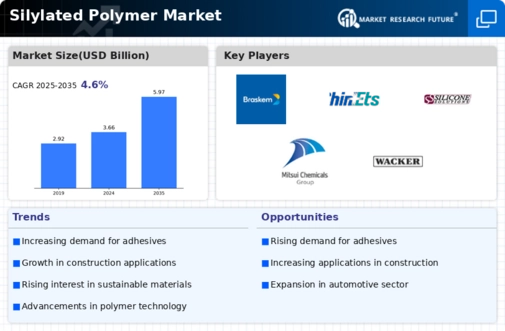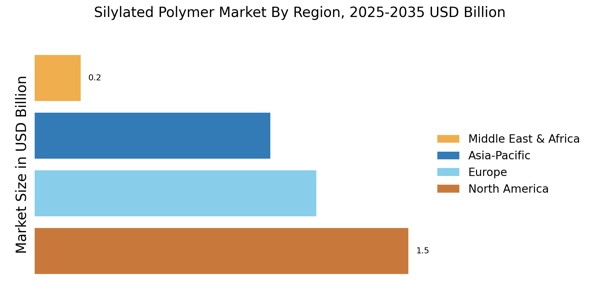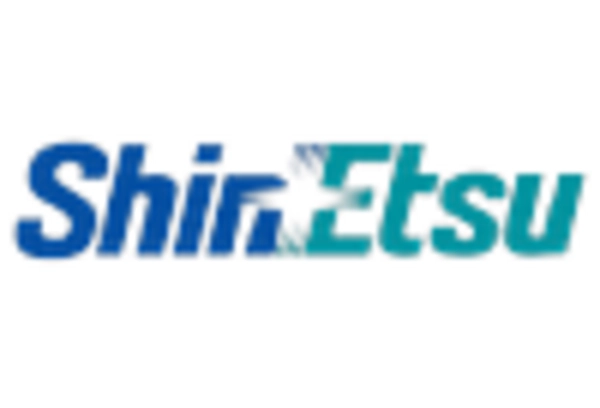Expansion in the Coatings Industry
The Silylated Polymer Market is poised for growth, particularly within the coatings sector. Silylated polymers are increasingly favored for their ability to enhance adhesion, durability, and resistance to environmental factors. The coatings market is anticipated to witness a robust expansion, with projections indicating a growth rate of approximately 5% annually. This trend is driven by the rising demand for high-performance coatings in various applications, including automotive, industrial, and architectural sectors. As manufacturers strive to develop innovative coating solutions, the incorporation of silylated polymers is likely to become more prevalent, thereby bolstering the Silylated Polymer Market. The versatility of these materials in providing protective and aesthetic benefits positions them as a key component in the evolving coatings landscape.
Increasing Adoption in Electronics
The Silylated Polymer Market is experiencing a notable increase in demand due to the growing adoption of advanced materials in the electronics sector. Silylated polymers are utilized in various electronic applications, including coatings, adhesives, and encapsulants, owing to their superior thermal stability and electrical insulation properties. The market for electronic components is projected to expand significantly, with estimates suggesting a compound annual growth rate of around 6% over the next few years. This growth is likely to drive the demand for silylated polymers, as manufacturers seek materials that enhance performance and reliability in electronic devices. As technology continues to evolve, the Silylated Polymer Market is expected to play a crucial role in meeting the material requirements of next-generation electronics.
Rising Demand for Sustainable Materials
The Silylated Polymer Market is increasingly influenced by the rising demand for sustainable materials across various sectors. As environmental concerns gain prominence, industries are seeking alternatives that minimize ecological impact. Silylated polymers, known for their durability and low environmental footprint, are becoming a preferred choice in applications ranging from construction to automotive. The market for sustainable materials is expected to grow significantly, with estimates suggesting a potential increase of 7% annually. This shift towards sustainability is likely to drive innovation within the Silylated Polymer Market, as manufacturers develop eco-friendly formulations that align with consumer preferences and regulatory requirements. The emphasis on sustainability not only enhances the market appeal of silylated polymers but also positions them as a vital component in the transition towards greener solutions.
Growth in Adhesives and Sealants Applications
The Silylated Polymer Market is benefiting from the increasing utilization of silylated polymers in adhesives and sealants. These materials offer exceptional bonding strength and flexibility, making them ideal for a wide range of applications, including construction, automotive, and consumer goods. The adhesives and sealants market is projected to grow at a rate of around 4% per year, driven by the demand for high-performance bonding solutions. As industries seek to improve product durability and performance, the adoption of silylated polymers is likely to rise. This trend not only enhances the functionality of adhesives and sealants but also contributes to the overall growth of the Silylated Polymer Market, as manufacturers explore innovative formulations to meet evolving market needs.
Technological Advancements in Polymer Chemistry
The Silylated Polymer Market is witnessing a surge in growth driven by technological advancements in polymer chemistry. Innovations in synthesis and formulation techniques are enabling the development of new silylated polymer variants with enhanced properties. These advancements are crucial for meeting the evolving demands of various industries, including automotive, electronics, and construction. The market for advanced polymer materials is projected to expand at a rate of approximately 5% annually, reflecting the increasing need for high-performance materials. As research and development efforts continue to focus on improving the functionality and versatility of silylated polymers, the Silylated Polymer Market is likely to benefit from the introduction of novel products that cater to specific application requirements.


















Leave a Comment